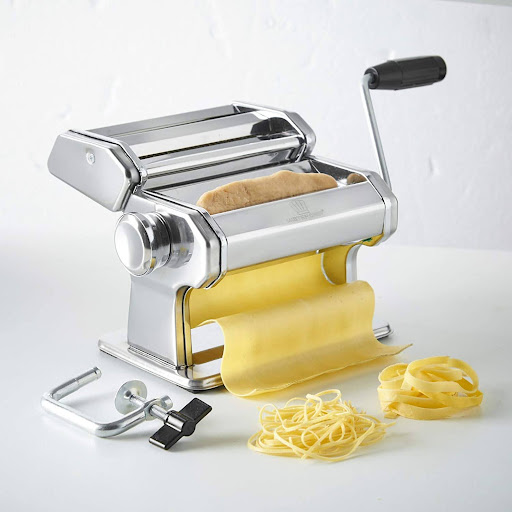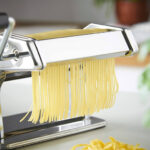Dried pasta has a fascinating history that dates back centuries. Legend has it that the Chinese were the first to create this culinary wonder by mixing wheat flour with water and then drying it. Fast forward to the 13th century, and these early noodles found their way to Italy, thanks to Marco Polo. Today, dried pasta is a go-to option in many households for a quick and easy dinner. All you have to do is open up a box, cook it in hot water, and add some pre-made sauce from a jar, and voila – dinner’s served in less than half an hour.
However, it seems like dried pasta has been on the receiving end of criticism from top chefs who swear by their fresh counterparts. But is dried pasta really that bad? In this blog post, we’re going to explore the differences between fresh and dried pasta and help you understand which one to use when. Let’s dive right in.
How Is Dried Pasta Made?
The process of making dried pasta is pretty simple. It includes 3 simple ingredients: semolina wheat flour, salt, and water. These ingredients are mixed together to form a smooth dough which is then kneaded and rolled into thin sheets, taking on a variety of iconic pasta shapes such as spaghetti, penne, and fusilli.
Following this, the pasta undergoes the critical drying stage. It is arranged on large trays or racks, where specialized equipment regulates the drying environment. This process can take anywhere from 12 to 48 hours depending on how thick the pasta is. Finally, once this is done, the pasta is packed into boxes, ready for distribution to retail outlets.
How Is Fresh Pasta Made?

Compared to dried pasta, fresh or homemade pasta is easier to make. It uses the same basic ingredients with the addition of eggs, additional water, and possibly olive oil. There is also no drying time required. You can cook it right away, and because it’s more tender, it cooks in about half the time.
Fresh Pasta vs Dried Pasta: What’s the Difference?
Here’s a breakdown of the difference between fresh and dry pasta:
Fresh Pasta
- It’s usually made with basic ingredients like eggs, water, semolina wheat flour, or all-purpose flour, salt, and olive oil (optional).
- It’s quick to make. It also cooks faster (around 2 minutes).
- It has a tender, delicate texture, making it a great choice for dairy-based or olive oil-based sauces.
- It has a short shelf life, usually a day or two in the refrigerator.
Dried Pasta
- It’s typically made with semolina flour, salt, and water. It can also include eggs but usually the powdered version.
- It takes more time to prepare due to the drying process. It also takes longer to cook (around 12 minutes).
- It has a firm texture, making it ideal for hearty sauces that cling well.
- It has a longer shelf life and can be stored in your pantry for months or even years.
When to Use Fresh Pasta
Since homemade or fresh pastas have tender and delicate textures as well as inherent eggy flavors, they’re best served with creamy or dairy-based sauces like alfredo, and carbonara, or plain sauces like butter and herb, pesto, or olive oil and garlic. Avoid using it in baked dishes or meals you plan to store in the fridge for later. Dry pasta is better suited for this job.
When to Use Dried Pasta
Dried pasta is best cooked “al dente,” which means it’s slightly firm to the bite. It pairs perfectly with thicker, hearty sauces like tomato-based or meat-based options such as bolognese, ragu, or marinara. It’s also great for baked dishes like lasagna or casseroles, as well as classic soups like chicken noodle or minestrone. Its firm texture allows it to hold up well without breaking apart when mixed.
How to Make Fresh Pasta from Scratch

Why buy fresh pasta when you can make it at home? Follow this step-by-step guide to make your own fresh pasta:
Ingredients You’ll Need:
- 2 cups of all-purpose flour or semolina flour
- 2 large eggs
- A pinch of salt
- Olive oil
Equipment You’ll Need:
- Mixing bowl
- Fork or dough whisk
- Rolling pin or pasta machine like the MisterChef Manual Pasta Maker
- Knife or pasta cutter
Step-by-Step Process of Making Fresh Pasta:
- Clear a clean, flat surface, like a counter, where you’ll be working. To keep the dough from sticking, lightly dust it with flour.
- Make a crater or well in the middle of the flour.
- Add a small pinch of salt and crack the eggs into the well.
- Whisk the eggs gently while slowly integrating the flour from the sides of the well.
- Continue mixing until a dough forms.
- After the dough has formed, knead it for approximately 5-10 minutes. Use the heel of your hand to push it away from you, then fold it back towards yourself. Continue this cycle until the dough becomes smooth and elastic.
- Cover the dough with plastic wrap and allow it to rest at room temperature for a minimum of 30 minutes.
- After resting, divide the dough into smaller portions.
- Flatten one portion with your hand and use a rolling pin or pasta machine to roll it out into a thin sheet. If using a pasta machine, start with the widest setting and gradually make it thinner.
- You can then cut the pasta into your desired shapes, like fettuccine, tagliatelle, or stuffed pasta ravioli.
- Next, you need to start cooking fresh pasta. Bring a large pot of salted water to a boil and add the pasta. Stir gently to prevent sticking and cook until it’s al dente (tender but with a slight bite).
- Drain the cooked fresh pasta and toss it with olive oil and your favorite sauce or ingredients.
Summary
The choice between fresh or dried pasta depends on your recipe and available time. Fresh pasta works well for dishes with lighter sauces and when you have extra time for preparation. On the other hand, dry pasta is convenient for dishes with heavier sauces and when you need a quick solution.
If you’re looking for a pasta maker to create restaurant-quality pasta at home, check out MisterChef. Our stainless-steel pasta maker features 9 settings, allowing you to effortlessly prepare everything from simple egg pasta to lasagna and fettuccini. Shop with us today.






